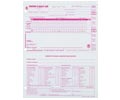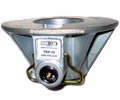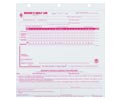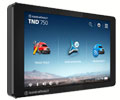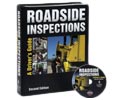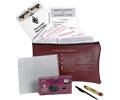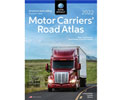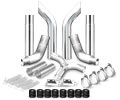FAQs - Transportation
Registrations
- 001 » How long must IRP and IFTA "operational records" be retained by the carrier?
- 002 » Does an interstate vehicle weighing 26,000 pounds (or less) that has not been registered under the International Registration Plan (IRP) receive registration reciprocity when operating in other IRP jurisdictions?
- 003 » What is a process agent?
Hazmat
- 004 » Can hazardous materials labels or placards be oriented other than square-on-point?
- 005 » When must a white-bottom COMBUSTIBLE placard be used to display an identification number?
- 006 » What does "n.o.s." mean?
- 007 » How often must a hazmat employee receive recurrent training?
Logs/DVIR
- 008 » Is the driver required to take a break during the 10/11 hours of driving?
- 009 » Who needs to fill out a log?
- 010 » Can a driver do non-driving work beyond the 60/70 hour limit?
- 011 » Does a part-time job on a farm count as on-duty time?
- 012 » Under what circumstances may a driver record meal stops as "off-duty" time?
- 013 » Is a separate daily duty status record required for each day off or each day of vacation?
- 014 » Can a driver be cited under Federal regulations for exceeding state speed limits?
- 015 » Is there a maximum number of hours a driver is allowed to be on duty in one calendar day?
- 016 » Can a carrier assign some of his drivers to an 8-day period (70 hours on duty) and others to a 7-day period (60 hours on duty)?
- 017 » Must a driver utilizing the 100-or-150-air-mile radius exemption carry documentation of the exemption?
- 018 » Must a driver vehicle inspection report be kept in the vehicle?
Drugs/Alcohol
- 019 » Do drivers need to be tested pre-employment for alcohol?
- 020 » Is a driver who is convicted of drunken driving in his/her personal car disqualified from driving a commercial motor vehicle (CMV)?
- 021 » Can drivers drive before the company receives drug test results?
- 022 » Where should DOT drug and alcohol files be stored?
- 023 » What is a DER?
Driver Qualification
- 024 » What has to be in a driver qualification file?
- 025 » What has to be in the Driver Investigation History file?
- 026 » Who must have a medical exam and certificate?
- 027 » Is the DOT physical form a requirement of the DQ file?
Definitions
- 028 » What is the definition of a commercial motor vehicle?
- 029 » What is a "private" carrier?
- 030 » What is the Federal Bridge Gross Weight Formula?
- 031 » What is the difference between interstate and intrastate commerce?
Registrations
How long must IRP and IFTA "operational records" be retained by the carrier?
The International Registration Plan (IRP) requires the licensee to preserve the records on which their apportioned registration application is based for the current application year, plus the three preceding mileage years.
The International Fuel Tax Agreement (IFTA) requires the records used for the quarterly tax return to be retained for four years from the return due date or filing date, whichever is later, plus any time period included as a result of waivers or jeopardy assessments. If a licensee fails to provide the required records for audit, the four-year retention requirement is extended until the required records are provided.
Does an interstate vehicle weighing 26,000 pounds (or less) that has not been registered under the International Registration Plan (IRP) receive registration reciprocity when operating in other IRP jurisdictions?
Not in all cases. Interstate vehicles 26,000 pounds or less may apportion under the IRP if they wish, but are not required to do so. Vehicles choosing not to apportion are subject to individual jurisdiction registration laws. Some states allow these non-apportioned vehicles to travel interstate in their jurisdictions but require a trip permit before operating intrastate; some require vehicles of 26,000 pounds or less to obtain trip permits before operating interstate or intrastate. Carriers should consult the states of travel to determine what permits may be needed.
What is a process agent?
A process agent receives legal service of documents in any proceeding brought against a motor carrier, broker, or freight forwarder. Every motor carrier, broker, or forwarder registered with the Federal Motor Carrier Safety Administration must file a Form BOC-3 listing the name and address of an agent for each state in which they will operate. Brokers are required to list process agents in each state in which they have an office and in which they write contracts.
HazMat
Can hazardous materials labels or placards be oriented other than square-on-point?
Although recommended when feasible, there is no requirement to orient a label square-on-point on a package. Some small packages are too small to permit square-on-point orientation, and many packages may be transported in any of several orientations. In other instances, labels may be attached to tags, rendering "square-on-point" meaningless.
For placards, 49 CFR §172.516(c)(5) mandates a square-on-point orientation (words or identification numbers displayed horizontally).
When must a white-bottom COMBUSTIBLE placard be used to display an identification number?
According to 49 CFR §172.332(c)(4), it must be used during transportation by rail and may (permissive) be used during transportation by highway.
What does "n.o.s." mean?
"Not otherwise specified" (49 CFR §171.8), which means the chemical is not listed by name in the Hazardous Materials Table, 49 CFR §172.101.
How often must a hazmat employee receive recurrent training?
Recurrent training is required at least once every three years.
To get help with training, see J. J. Keller's Hazmat Training Made Easier For All Employees program.
Is the driver required to take a break during the 10/11 hours of driving?
The Hours of Service Regulations (49 CFR 395) do not contain any requirement for a break in driving time as such. But other parts of the federal safety regulations (e.g., §392.9) require the driver to check the load on a regular schedule which would thus require stops.
Who needs to fill out a log?
The requirements for logging are contained in the hours of service regulations. Any driver who operates a commercial motor vehicle in interstate commerce is subject to the hours of service regulations. A commercial motor vehicle, for this purpose, is defined as a vehicle that:
- has a gross vehicle weight rating, gross combination weight rating, gross vehicle weight, or gross combination weight of 10,001 pounds or more;
- is designed to transport more than 8 passengers (including the driver) for compensation;
- is designed to transport more than 15 passengers (including the driver) and is not used to transport passengers for compensation; or
- is transporting hazardous materials in a quantity requiring the vehicle to be placarded.
Within the hours of service regulations are logging exemptions for drivers that meet the criteria of either the 100 air-mile radius exemption or the non-CDL short-haul exemption (§ 395.1(e)). For drivers who come under one of these exemptions, a time record may be filled out in lieu of a log.
Drivers operating in intrastate commerce should check with their state about what the requirements and exemptions are for logging.
Can a driver do non-driving work beyond the 60/70 hour limit?
Yes, the driver can do non-driving work beyond the limit and not be in violation, but those hours must be added to the total.
Does a part-time job on a farm count as on-duty time?
Yes, hours spent doing any compensated work for any nonmotor carrier must be counted as on-duty time.
Under what circumstances may a driver record meal stops as "off-duty" time?
The driver must have written instructions from his employer, received prior to his/her departure, relieving him/her of all duty and all responsibility for the vehicle and its cargo for a definite period of time sufficient to reduce fatigue, and the driver must be at liberty to pursue activities of his/her own choosing and to leave the premises on which the vehicle is situated.
Is a separate daily duty status record required for each day off or each day of vacation?
Although a driver must account for each day of the month, it is permissible to show consecutive days off on a single duty status record sheet. An entire vacation can be shown on one sheet by drawing a line through the "off-duty" category of the graph and noting in the "Remarks" portion the inclusive dates, i.e., "Vacation March 13 through March 26."
Can a driver be cited under Federal regulations for exceeding state speed limits?
Yes! Federal statutes say that you must abide by state laws and regulations.
Is there a maximum number of hours a driver is allowed to be on duty in one calendar day?
No. Although often the 15/14 hours of service rule is thought to be such a limitation, a driver can be on duty continuously for 24 hours or any number of hours in a row, BUT after 15/14 hours of duty he/she must have 8/10 consecutive hours off duty before he/she can again drive a vehicle.
Can a carrier assign some of his drivers to an 8-day period (70 hours on duty), and others to a 7-day period (60 hours on duty)?
Yes. If the carrier operates every day of the week, some drivers can be assigned to work on an 8-day basis and some on a 7-day basis.
Must a driver utilizing the 100-or-150-air-mile radius exemption carry documentation of the exemption?
No. 49 CFR §395.1(e) does not require a driver to carry anything documenting that he/she qualifies for the exemption.
Must a driver vehicle inspection report be kept in the vehicle?
No. The Federal Motor Carrier Safety Regulations used to require that a copy of the driver vehicle inspection report (DVIR) be kept in the vehicle, but that requirement was removed several years ago. However, if you travel in Canada, Canadian provinces require the DVIR in the vehicle.
Do drivers need to be pre-employment tested for alcohol?
No, employers are allowed to, but are not required to, conduct pre-employment tests for alcohol. If you do choose to conduct such tests, you must comply with 49 CFR §382.301(d).
Is a driver who is convicted of drunken driving in his/her personal car disqualified from driving a commercial motor vehicle (CMV)?
Possibly, depending on the type of license the driver has. As of September 30, 2002, if you hold a commercial driver’s license (CDL) and are convicted of being under the influence of alcohol while operating any type of vehicle, including a personal vehicle, or if you refuse to be tested, you may be disqualified from operating a CMV. However, a conviction in a non-CMV is not a DOT alcohol violation under Parts 40 and 382. It does not require a Substance Abuse Professional (SAP) evaluation and treatment.
If you do not have a CDL and you are convicted of drunken driving in a personal vehicle, you would not be disqualified from operating a CMV. However, if the drunken driving conviction led to suspension or revocation of your driver’s license, you obviously would not be allowed to continue driving any vehicle until the license was reinstated.
Can drivers drive before the company receives drug test results?
If a carrier is pre-employment testing a newly hired driver, the company must receive negative test results before allowing the driver to drive. Not waiting for negative test results has led to fines for many companies.
A driver who has taken a random or post-accident drug test may continue to drive while test results are being processed. A carrier would only have to remove the driver from safety-sensitive functions if and when a confirmed positive result was received.
Where should DOT drug and alcohol files be stored?
According to 49 CFR §382.401(a), records related to a company’s DOT drug and alcohol testing program must be kept in a secure location with controlled access.
What is a DER?
A designated employer representative (DER) is a company employee who has been chosen to receive communications and test results as part of a company’s DOT drug and alcohol testing program. The DER can take immediate action to remove employees from safety-sensitive duties and to make required decisions in the testing and evaluation processes.
What has to be in a driver qualification file?
A driver qualification file must include the following:
- the driver’s employment application;
- a written record of each state agency that was contacted during the carrier’s investigation of the driver;
- the certificate of the driver’s road test or a copy of the license or certificate the carrier accepted as equivalent to a road test;
- the response of each state agency to the annual driver record inquiry;
- a note relating to the annual review of the driver’s driving record;
- a list or certificate relating to violations of motor vehicle laws and ordinances;
- the medical examiner’s certificate of the driver’s physical qualifications or a photocopy of the certificate; and
- a letter granting a waiver of a physical disqualification if a waiver was issued under §391.49.
For drivers hired prior to the October 30, 2004 Safety Performance History inquiry, the general employment verification in the earlier version of §391.23 must be retained in the DQ file in accordance with the old rules.
What has to be in the Driver Investigation History file?
The file must contain all records related to the investigation into the safety performance history of new or prospective drivers. The file must be maintained in a secure location with controlled access. At a minimum, the file must include the following: a copy of the driver's written authorization for the employer to seek information about the driver's drug/alcohol history; a copy of the response(s) received from each previous employer, in writing, including the previous employer's name and address, the date of contact, and the information received about the driver; and documentation of failures to contact a previous employer, or the employer's failure to provide the required information.
Who must have a medical exam and certificate?
Any driver who operates a commercial motor vehicle in interstate commerce must have a medical exam and certificate per 49 CFR §391.43. A commercial motor vehicle, for this purpose, is defined as a vehicle that:
- has a gross vehicle weight rating, gross combination weight rating, gross vehicle weight, or gross combination weight of 10,001 pounds or more;
- is designed to transport more than 8 passengers (including the driver) for compensation;
- is designed to transport more than 15 passengers (including the driver) and is not used to transport passengers for compensation; or
- is transporting hazardous materials in a quantity requiring the vehicle to be placarded.
Motor carriers that have drivers operating in intrastate commerce only should check with their states to see what the state’s requirements are for medical exams and certificates.
Is the DOT physical form a requirement of the DQ file?
No. The DOT physical form is not listed in 49 CFR §391.51 as a required DQ file item. The medical examiner's certificate is a requirement, however. The medical examiner is required to keep the long-form original on file at his/her office. If a carrier obtains a copy, they are not required to retain it in the DQ file. Employers need to retain the long-form physical in accordance with the Equal Employment Opportunity Commission (EEOC). The form cannot be kept in the DQ file or other personnel-type of file. It must be in a separate, confidential medical file that is secured with controlled access.
What is the definition of a commercial motor vehicle?
There are two different definitions of a commercial motor vehicle (CMV) in the Federal Motor Carrier Safety Regulations. Which definition applies depends on which regulations are being referenced.
The general definition of a CMV is found in §390.5 and refers to a vehicle used in interstate commerce. According to this definition, a CMV is a vehicle that:
- has a gross vehicle weight rating, gross combination weight rating, gross vehicle weight, or gross combination weight of 10,001 pounds or more;
- is designed to transport more than 8 passengers (including the driver) for compensation;
- is designed to transport more than 16 passengers (including the driver) and is not used to transport passengers for compensation; or
- is transporting hazardous materials in a quantity requiring the vehicle to be placarded.
The regulations in Parts 390 through 396 apply to drivers of vehicles meeting this definition. These regulations include driver qualification, hours of service, and inspection and maintenance requirements.
A different definition of a CMV is used in Parts 382 and 383, the regulations dealing with the commercial driver’s license and drug and alcohol testing. This CMV definition refers to vehicles used in interstate or intrastate commerce. According to this definition, a CMV is a vehicle that:
- has a gross combination weight rating of 26,001 pounds or more inclusive of a towed unit with a gross vehicle weight rating of more than 10,000 pounds;
- has a gross vehicle weight rating of 26,001 pounds or more;
- is designed to transport 16 or more passengers, including the driver; or
- is transporting hazardous materials in a quantity requiring the vehicle to be placarded
Drivers must have a CDL and undergo drug and alcohol testing if they drive vehicles meeting the definition stated above. This same definition, applicable only to interstate commerce, places a driver under entry-level driver training requirements found in Part 380.
What is a “private” carrier?
Private carriage exists when:
- Property is transported by a person engaged in a business other than transportation; and
- The transportation is within the scope of and furthers a primary business (other than transportation) of the person.
Private carriers may only transport their own goods in their own vehicles to further a primary business that is not trucking. Hauling goods for someone else for compensation requires for-hire operating authority.
What is the Federal Bridge Gross Weight Formula?
The Federal Bridge Formula limits the weight on groups of axles in order to reduce the risk of damage to highways and bridges. Allowable weight depends on the number of axles a vehicle has and the distance between those axles.
What is the difference between interstate and intrastate commerce?
Interstate commerce is the movement of a shipment or service across state or international borders, or the intent to continue a movement within a state that originated from another state or country. In practical terms, you could still be considered interstate commerce even if you never cross the state line, depending upon the origin and destination of the shipment or service.
Intrastate commerce is the movement that originates in a single state, moves in that state only and delivers in that originating state.
49 CFR §390.5 defines these terms.
Highly Recommended
Track Your Order



